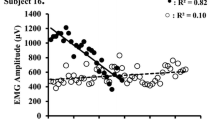Abstract
The relationship between the integrated EMG of the biceps (Q B) and positive work (W) was examined for isolated and to and fro movements of the elbow. The movements were performed against either pure inertias or against loads.
-
1.
In all cases, a linearQ B—W relationship was found.
-
2.
For isolated movements, theQ B—W curve showed the same slope whether the movement was carried out against an inertia or against a load.
-
3.
When the movements were carried out against an inertia, the slope of theQ B—W curve was steeper for isolated movements than for to and fro ones.
These results show that:
-
a)
for the movements against a load, the extra component of the integrated EMG arising from the initial isometric phase is compensated by the mechanical work resulting from the release of potential elastic energy;
-
b)
for the to and fro movements, elastic energy is stored in the stretched series elastic component during the negative work and released during the positive work. However, in this case, the biceps cannot escape from performing negative work which is necessary to decelerate the extension movement and so, it appears less energy expenditure relatively to the isolated movement.
Résumé
La comparaison des relations entre l'EMG intégré (Q B) et le travail en raccourcissement du biceps brachii (W) au cours de mouvements de flexion isolés, effectués contre inerties et résistances d'une part, et de mouvements isolés et de va-et-vient effectués contre inerties d'autre part, montre que:
-
1.
Les relationsQ B =f(W) sont toujours linéaires dans les limites de notre expérimentation (W<15 joules).
-
2.
Les pentes des relations pour des mouvements isolés, effectués contre inerties et contre résistances ne sont pas significativement différentes.
-
3.
La pente de la relation, lors de mouvements isolés effectués contre inerties est significativement supérieure à celle obtenue lors de mouvements de va-et-vient.
Ceci montre que:
-
a)
dans le mouvement contre résistance, au supplément d'EMG intégré développé lors de la phase de contraction isométrique, correspond un surcroît de travail mécanique obtenu par restitution de l'énergie potentielle élastique;
-
b)
dans le cas du mouvement de va-et-vient, la composante élastique stocke de l'énergie potentielle pendant la phase de travail en allongement et restitue cette énergie lors du travail en raccourcissement. Cependant, le préétirement correspond à une phase de travail résistant, nécessaire pour limiter l'extension. Il apparaît donc une économie d'énergie par rapport au mouvement isolé.
Similar content being viewed by others
Bibliographie
Asmussen, E., Sorensen, N.: The “wind up” movement in athletics. Trav. Hum.34, 147–156 (1971).
Aubert, X.: Le couplage énergétique de la contraction musculaire. Bruxelles: Arscia 1956
Bahler, A. S.: Series elastic component of mammalian skeletal muscle. Amer. J. Physiol.213, 1560–1564 (1967)
Bouisset, S.: EMG and muscle force in normal motor activities. In: New developments in EMG and clinical neurophysiology, Vol. 1, J. E. Desmedt, ed., pp. 547–583. Basel: Karger 1973
Bouisset, S., Goubel, F.: Integrated electromyographical activity and muscle work. J. appl. Physiol.35, 695–702 (1973)
Bouisset, S., Pertuzon, E.: Experimental determination of the moment of inertia of limb segments. Biomechanics I, 1st Int. Seminar, Zürich (1967), pp. 106–109. Basel: Karger 1968
Cavagna, G. A.: Travail mécanique dans la marche et dans la course. J. Physiol. (Paris)61 (Suppl. I), 3–42 (1969)
Cavagna, G. A., Dusman, B., Margaria, R.: Positive work done by a previously stretched muscle. J. appl. Physiol.24, 21–32 (1968)
Cavagna, G. A., Saibene, F. P., Margaria, R.: Mechanical work in running. J. appl. Physiol.19, 249–256 (1964)
Cavagna, G. A., Saibene, F. P., Margaria, R.: Effect of negative work on the amount of positive work performed by an isolated muscle. J. appl. Physiol.20, 157–158 (1965)
Cnockaert, J. C.: Etude de l'organisation d'un mouvement simple de va-et-vient. Application à la recherche d'un rythme optimal Lille: D.E.S. 1968
Cnockaert, J. C.: Comparaison électromyographique du travail en allongement et en raccourcissement au cours de mouvements de va-et-vient. Electromyogr. clin. Neurophysiol. (à paraître)
Elftman, H.: Biomechanics of muscle. J. Bone Jt Surg.48, 363–377 (1966)
Fenn, W. O.: Some elasticity problems in the human body. In: Tissue elasticity, J. W. Remington, ed. pp. 98–101. Wawerly Press 1957
Feuer, D.: Intégrateur convertisseur (analogique-numérique). Application à l'évaluation de l'activité électrique cellulaire. J. Physiol. (Paris)59, 319–321 (1967)
Hill, A. V.: The heat of shortening and the dynamic constants of muscle. Proc. roy. Soc. B126, 136–195 (1938)
Hill, A. V.: The series elastic component of muscle. Proc. roy. Soc. B137, 273–280 (1950)
Margaria, R.: Positive and negative work performances and their efficiencies in human locomotion. Int. Z. angew. Physiol.25, 339–351 (1968)
Margaria, R., Cavagna, G. A., Saibene, F. P.: Possibilita di struttamento dell'elasticita del muscolo contratto durante l'essercizio muscolare. Boll. Soc. ital. Biol. sper.39, 1815–1816 (1963)
Pertuzon, E., Lestienne, F.: Détermination dynamique de la position d'équilibre d'une articulation. Int. Z. angew. Physiol.31, 315–325 (1973)
Thys, H., Faraggiana, T., Margaria, R.: Utilization of muscle elasticity in exercise. J. appl. Physiol.32, 491–493 (1972)
Wilkie, D. R.: The relation between force and velocity in human muscle. J. Physiol. (Lond.)110, 249–280 (1950)
Author information
Authors and Affiliations
Rights and permissions
About this article
Cite this article
Cnockaert, J.C., Goubel, F. Rôle de l'énergie potentielle élastique dans le travail musculaire. Europ. J. Appl. Physiol. 34, 131–140 (1975). https://doi.org/10.1007/BF00999925
Received:
Issue Date:
DOI: https://doi.org/10.1007/BF00999925




